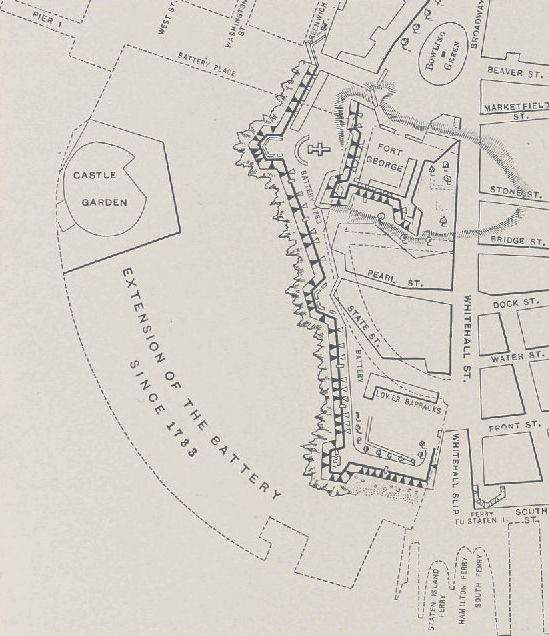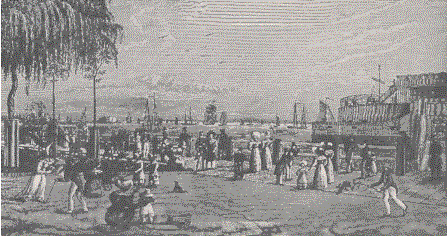|
 |

Part of the American
History & Genealogy Project |
The Battery, New York


The Fort and Battery, 1750
When Hendrick Hudson came sailing into
the mouth of the river that thenceforward was to be known by his
name, on that September day in the year 1609, almost the whole
of what now is called "the Battery" was under water at high
tide. And it is a fact, notwithstanding the thundering of guns
which has gone on thereabouts, and the blustering name that the
locality has worn for more than two centuries, that not a single
one of New York's enemies ever would have been a whit the worse
had the tides continued until this very moment to cover the
Battery twice a day! Actually, the entire record of this
theoretically offensive institution, whereof the essential and
menacing purpose, of course, was that somebody or something
should be battered by it, has been an aggregation of gentle
civilities which would have done credit to a rather
exceptionally mild-mannered lamb.
Most appropriately, this affable
offspring of Bellona came into existence as the friendly prop to
a still more weak-kneed fort. For reasons best known to
themselves, the Dutch clapped down what they intended should be
the main defense of this island upon a spot where a fort, save
as a place of refuge against the assaults of savages, was no
more than a bit of military bric-a-brac. Against the savages it
did, on at least one occasion, serve its purpose; yet had even
these attacked it resolutely they must surely have carried it:
since each of the Dutch governors has left upon record bitter
complaining of the way in which it was invaded constantly by
cows and goats who triumphantly marched up its earthen ramparts
in nibbling enjoyment of its growth of grass. When the stress of
real war came, with the landing of the English forces in the
year 1664, the taking of this absurd fort was a mere bit of
bellicose etiquette: a polite changing of garrisons, of fealty,
and of flags.
Later, when Governor Stuyvesant very
properly was hauled over the coals for the light-handed way in
which he had relinquished a valuable possession, his explanation
did not put the matter in much better shape. "The Fort," he
wrote, "is situated in an untenable place, where it was located
on the first discovery of New Netherland, for the purpo.se of
resisting an attack of the barbarians rather than an assault of
European arms; having, within pistol-shot on the north and
southeast sides, higher ground than that on which it stands, so
that, notwithstanding the walls and works are raised highest on
that side, people standing and walking on that high ground can
see the soles of the feet of those on the esplanades and
bastions of the Fort."
Having themselves so easily captured it,
the English perceived the need of doing something to the Fort
that would enable them to hold it against the Dutch in the
probable event of these last trying to win it back again. The
radical course of abandoning it to the cows and goats and
building a new fort upon higher ground, on, for instance, the
high bluff above the river-side where Trinity Church now stands,
would have been the wisest action that could have been taken in
the premises; but the very human tendency to try to improve an
existing bad thing, rather than to create a new good thing,
restrained them from following out this one possible line of
effectual reform. Raising the walls of the Fort was talked about
for a while; until Colonel Cartwright, the engineer, put a
stopper upon this suggestion by declaring, in effect, that
taking the walls up to the height of those of Jericho would not
make the place tenable. And then, after more talk, the decision
was reached that to build a battery under the walls of the Fort
would be to create defenses "of greater advantage and more
considerable than the Fort itself": whereupon this work was
taken in hand by General Leverett and carried briskly to
completion and from that time onward the Battery has been part
and parcel of New York.
The amount of land which then
constituted the Battery was trifling: as is shown by the
statement in Governor Dongan's report to the Board of Trade
(1687), "the ground that the Fort stands upon and that belongs
to it contains in quantity about two acres or thereabouts." The
high-water mark of that period would be indicated roughly by a
line drawn with a slight curve to the westward from the foot of
the present Greenwich Street to the intersection of the present
Whitehall and Water streets. All outside of this line is made
land which has been won from the river, the greater part of it
within the past forty years, by filling in over the rocks which
fringed this southwestern shore.
This primitive Battery was but a small
affair, loosely constructed and lightly armed. As to its
armament, the report of the survey ordered in the year 1688
contains the item : "Out the Fort, under the flag-mount, near
the water-side, 5 demi culverins;" and its inherent structural
weakness is shown by the fact that only five years after its
erection-that is to say, in 1689, when Leisler's righteous
revolt made the need for strong defenses urgent, its condition
was so ruinous as to be beyond repair; wherefore it was replaced
by "a half-moon mounting seven great guns."
As the event proved, this half-moonful
of guns would have satisfied for almost another century all that
might have been (but was not) required of artillery in this
neighborhood. But the times were troublous across seas; and the
Leisler matter had proved that questions of European abstract
faith and concrete loyalty might exercise a very tumultuous and
dismal influence upon American lives. And so the prudent New
Yorkers, about the year 1693, decided to bring their waterside
defenses to a condition of high efficiency by building "a great
battery of fifty guns on the outmost point of rocks under the
Fort, so situated as to command both rivers," and, incidentally,
to defy the world.

Extension of the Battery Since 1783
In the mere planning of this nobly
defiant undertaking there seems to have been gained so
comforting a sense of security that its realization was not
arrived at for nearly half a century, as appears from Governor
Clarke's statement (1738): "There is a battery which commands
the mouth of the harbor, whereon may be mounted 50 cannon. This
is new, having been built but three years, but it wants
finishing." In the course of the ensuing thirty years, possibly
even sooner, the finishing touches seem to have been supplied;
at least, the Battery is shown as completed on Ratzen's map of
1767; and it is certain that these defenses were in effective
condition while New York was held by the English during the
Revolutionary War. Indeed, during the Revolutionary period the
Battery really was a battery of some importance: as may be seen
by the accompanying plan, showing a line of works extending from
the foot of Greenwich Street along all the water-front to
Whitehall Slip. But what made the Battery harmless at that,
potentially, most belligerent period of its history was
precisely what has made it harmless throughout the whole of its
kindly career: the absolute absence of an enemy at whom to
discharge its guns.
When the Revolutionary War was ended the
nonsensical Fort at last was demolished, which was good riddance
to amusingly bad rubbish and with it the Battery went too. Why
this last was razed is not at all clear. Unlike the Fort, it was
not in anybody's way, and it was not a military laughing-stock.
On the contrary, it occupied an otherwise unused corner of the
island, and so well commanded the entrance to the East and North
rivers that it was saved from being deadly dangerous only by the
persistent absence of a foe. Indeed, in theory, at least, it was
so reasonable a bit of fortification that when we went to
fighting England again, in the year 1812, it immediately was
built up anew. During that period of warfare, of course, nothing
more murderous than blank cartridge was fired from its eager
guns; but there it was, waiting with its usual energy for the
chance to hurt somebody which (also as usual) never came.
Meanwhile there had been set up in this
region another military engine of destruction which, adapting
itself to the gentler traditions of its environment, never came
to blows with anybody, but led always a life of peaceful
usefulness that is not yet at an end. This was the Southwest
Battery: that later was to be known honorably as Castle Clinton;
that still later was to become notable, and then notorious, as
Castle Garden; and that at the present time is about to take a
fresh start in respectability as the Aquarium.
It is not easy to realize, nowadays, as
we see this chunky little fort standing on dry ground, with a
long sweep of tree-grown park in its rear, that when it was
built, between the years 1807 and 1811, it was a good hundred
yards out from the shore. Its site, ceded by the city to the
Federal Government, was a part of the outlying reef known as
"the Capske" and when the fort was finished the approach to it
was by way of a long bridge in which there was a draw. The
armament of this stronghold was twenty-eight 32-pounders: and
when these went banging off their blank-cartridges in salutes,
and clouds of powder-smoke went rolling down to leeward, there
was not a more pugnacious-looking little fume of a fort to be
found in all Christendom.
The Battery Park, or Battery Walk, as it
indifferently was called, of that period was a crescent shaped
piece of ground of about ten acres, being less than half the
size of the Battery Park of the present day, which ended at the
water-side in a little bluff, capped by a wooden fence, with a
shingly beach beyond. Along the edge of the bluff the earthworks
of the year 1812 were erected, and were neither more nor less
useful than the wooden fence which they replaced. However, what
with the grim array of guns lowering over the earthen parapet,
and the defiant look of the obese little fort, the New York of
that epoch mu.st have worn to persons approaching it from the
seaward, being for the most part oystermen and the crews of
Jersey market-boats, a most alarmingly swaggering and dare-devil
sort of an air.

The Battery, 1822
Yet was there a cheerful silver lining
to these dismally black clouds of war. In his admirable
monograph upon " New York City during the War of 1812-15," Mr.
Guernsey writes: "In the summer of 1812 there was occasionally
music after supper, at about 6:30 P.M., at the Battery
flagstaff," which " stood at the southeast end of the Battery
parade, and was surrounded by an octagon enclosure of boards,
with seats inside and a roof to shelter from the weather.
Refreshments and drinks were served from this building, and a
large flag was displayed from the pole at appropriate times."
Never, surely, was there a more charming exhibition of combined
gentleness and strength than then was made: when the brave men
of New York, night after night, gallantly invited the beautiful
women their fellow-citizens to partake of "refreshments and
drinks" close beside the stern rows of deadly cannon, and
beneath the flag to defend which, as the women themselves, they
were sworn! In all history there is no parallel to it: unless,
perhaps, it might be likened to the ball and the battle of
Waterloo, with the battle left out.
Even the New-Yorkers of that period,
whose infusion of Dutch blood still was too strong to permit
them easily to assimilate ideas, could not but perceive that as
a place of recreation, where refreshments and drinks could be
had to a musical accompaniment, the real use of their
pseudo-Battery at last had been found. Out of this rational view
of the situation came the project, formulated soon after Castle
Clinton was receded to the city, in the year 1822, upon the
translation of the Federal military headquarters to Governor's
Island, to make over the fort into a place of amusement; which
project was realized, and Castle Garden came into existence, in
the year 1824. From that time onward, through all the phases of
its variegated career, as concert-hall, place of civic assembly,
theatre, immigrant depot, armory, the building at least has been
able to account for itself on grounds whereof the mere statement
would not, as in the days when it was pretending to be a fort,
instantly excite a grin.
With the departure from Castle Clinton
of the last of its 32-pounders went also the last vestige of an
excuse on the part of the Battery for retaining its Sir Lucius
O'Trigger of a name. But in that region, fortunately, old names
live on. There are the Beaver's Path and the Maiden's Lane, the
first of which has ceased to be the exclusive property of
beavers, and the second of maidens, for more than two and a half
centuries; there is the Wall Street, whence the wall departed
about A.D. 1700; and there is the Bowling Green, where bowls
have not been played for well on toward two hundred years. With
these admirable precedents to stay and to strengthen it in use,
there is no fear that the name of the Battery soon will pass
away. And even should the brave name be lost in the course of
ages, still, surely, must be preserved always the gracious
legend of those peaceful guns which never thundered at a foe.
AHGP New York

Source: Stories from Early New York
History, by Sherman Williams, New York, Charles Scribner's Sons,
1906
|